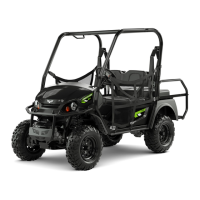16
OPERATION
Pre - Ride Inspection
Inspect and verify that the vehicle is in safe operating condition before each use to decrease the risk of an accident. Check the items in the table to help ensure
safe and reliable operation.
Hydrogen gas is generated as a natural part of the lead acid battery charging process. A 4% concentration of hydrogen
gas is explosive and could cause severe injury or death. Charging must take place in an area that is adequately venti-
lated (minimum of 5 air exchanges per hour).
To reduce the chance of battery explosion that could result in severe injury or death, never smoke around or charge
batteries in an area that has open flame or electrical equipment that could cause an electrical arc.
Hydrogen gas is generated in the charging cycle of batteries and is explosive in concentrations as low as 4%. Because hydrogen gas is lighter than air, it will
collect in the ceiling of buildings necessitating proper ventilation.
Five air exchanges per hour is considered the minimum requirement.
Never charge a vehicle in an area that is subject to flame or spark. Pay particular attention to natural gas or propane water heaters and furnaces.
Portable Charger
Use the portable charger ONLY on 72 volt battery systems. Other usage may cause personal injury and damage. Lead
acid batteries may generate explosive hydrogen gas during normal operation. Keep sparks, flames, and smoking mate-
rials away from batteries. Provide adequate ventilation during charging. Never charge a frozen battery. Study all battery
manufacturers’ specific precautions such as recommended rates of charge and removing or not removing cell caps
while charging.
Risk of electric shock. Connect charger power cord to an outlet that has been properly installed and grounded in accor-
dance with all local codes and ordinances. A grounded outlet is required to reduce risk of electric shock – do not use
ground adapters or modify plug. Do not touch uninsulated portion of output connector or uninsulated battery
terminal.
Disconnect the AC supply before making or breaking the connections to the battery while charging. Do not open or dis-
assemble charger. Do not operate charger if the AC supply cord is damaged or if the charger has received a sharp blow,
been dropped, or otherwise damaged in any way – refer all repair work to qualified personnel. Not for use by children.
The portable charger is shipped with the vehicle. Prior to vehicle or charger operation, the charger must be removed from the vehicle. A dedicated circuit
is required for the charger. Refer to the charger manual for appropriate circuit protection. For optimum performance and shortest charge times, place the
charger in an area with adequate ventilation and relatively free of dirt, mud, or dust. If the charger is operated in an outdoor location, rain and sun protection
must be provided. The charger may get hot during operation and must be placed such that risk of contact by people is reduced.
NOTICE: Looping the DC cord through the steering wheel when charging serves as a good reminder to store the cord out of the way when finished
with charging. The DC plug can be damaged by driving over or catching the cord on the vehicle when driving away.
To reduce the possibility of a physical hazard that could result in an electrical shock or electrocution, be sure that the
charger plug is not damaged and is inserted into a grounded receptacle.
An ungrounded electrical device may become a physical hazard that could result in an electrical shock or electrocution.
Item Check
Brake system/pedal travel Check for proper operation.
Brake fluid Check for correct level.
Park Ensure vehicle does not roll when the key is in the OFF position.
Front suspension Inspect. Lubricate if necessary. Check for loose or missing hardware.
Rear suspension Inspect. Lubricate if necessary. Check for loose or missing hardware.
CV boots Inspect for damage. Replace if necessary.
Steering Check for smooth and free operation.
Tires Check condition and pressure.
Wheel hardware Check for loose or missing hardware.
Frame hardware Check for loose or missing hardware.
Battery Check battery charge level.
Switches and indicator lights Check operation.
Headlights Check operation.
Brake light / taillights Check operation.
Seat belts Check entire length of belt for damage. Check latch operation.
Side Nets Inspect side nets and latches for damage. Check for loose or missing hardware.

